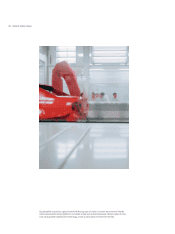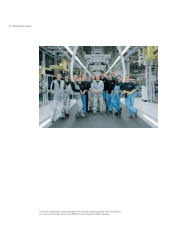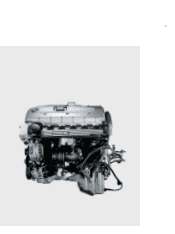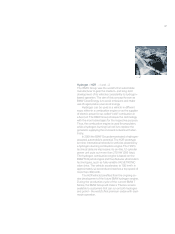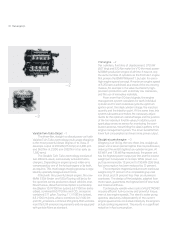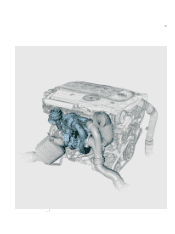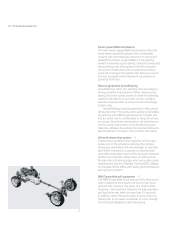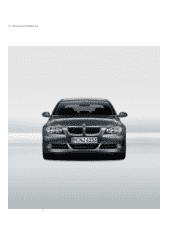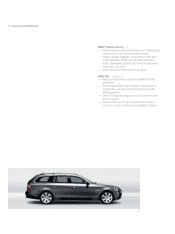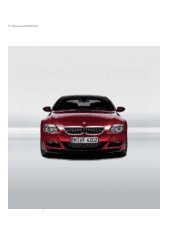BMW 2004 Annual Report Download - page 178
Download and view the complete annual report
Please find page 178 of the 2004 BMW annual report below. You can navigate through the pages in the report by either clicking on the pages listed below, or by using the keyword search tool below to find specific information within the annual report.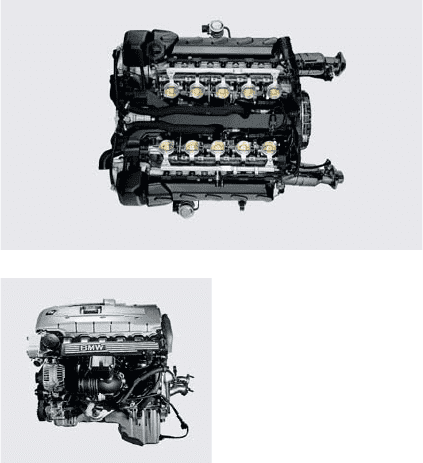
48 New engines
V10 engine --2
Ten cylinders, five litres of displacement, 373 kW
(507 bhp) and 520 Nm make the V10 the most power-
ful BMW production engine of all time. It has not only
the same number of cylinders as the Formula 1 engine
that powers the BMW WilliamsF1, but also the same
high engine speed concept. A maximum engine speed
of 8,250 rpm is achieved as a result of the low moving
masses, for example in the valve mechanism, high-
precision production with extremely low tolerances,
and the use of innovative materials.
From more than 50 input signals, the engine
management system calculates for each individual
cylinder and for each individual cycle the optimum
ignition point, the ideal cylinder charge, the injection
quantity and the injection point. At the same time, this
system calculates and makes the necessary
adjust-
ments for the optimum camshaft angle and the position
of the ten individual throttle valves. In addition, each
spark plug serves as sensor for monitoring the com-
bustion process, transmitting the data it gathers to the
engine management system.The driver benefits from
lower fuel consumption and even more power output.
Straight-six petrol engine --3
Weighing in at 161 kg, the new three-litre, straight-six
power unit is seven percent lighter than its predecessor,
making it the world’s lightest six-cylinder engine. At
63 kW/l and 1.18 kW/kg respectively, the power unit
has the highest power output per litre and the lowest
weight per horsepower in its class. While power out-
put has increased by 12 percent to 190 kW (258 bhp),
fuel consumption has been reduced by 12 percent.
The composite magnesium/aluminium crankcase
weighs only 57 percent of a comparable grey-cast
iron block and 24 percent less than an aluminium
crankcase. The design of the bedplate, adapted from
motor sport, guarantees the highest level of structural
and torsional stiffness.
Continuously variable valve control VALVETRONIC
ensures efficient fuel economy and powerful torque,
even at low engine speeds.The electric water pump
operates absolutely independently of the current
engine speed and is controlled entirely by the engine’s
actual cooling requirement.This results in a significant
reduction in fuel consumption.
--2
--3
Variable Twin Turbo Diesel --1
The three-litre, straight-six diesel power unit with
Variable Twin Turbo technology (multi-stage charging)
is the most powerful diesel engine of its class. It
develops output of 200 kW (272 bhp) at 4,400 rpm
and 560 Nm at 2,000 rpm (530 Nm at as early as
1,500 rpm).
The Variable Twin Turbo technology consists of
two different-sized, successively activated turbo-
chargers. Depending on engine speed, intake air is
compressed by one of the turbochargers or by both,
as required. This multi-stage charging process is regu-
lated by specially designed electronics.
Fitted with the powerful diesel engine, the new
BMW 535d Sedan and 535d Touring will be by far
the sportiest series-production diesel vehicles ever.
Nevertheless, diesel fuel consumption is particularly
low (Sedan: 10.9 l/100 km (urban), 6.3 l/100 km (extra-
urban), combined 8.0 l/100 km and CO2emissions
combined 211 g/km.Touring: 11.1 l/100 km (urban),
6.5 l/100 km (extra-urban), combined 8.2 l/100 km
and CO2emissions combined 216 g/km). Both vehicles
meet the EU4 emission requirements and are equipped
with particle filters as standard.


